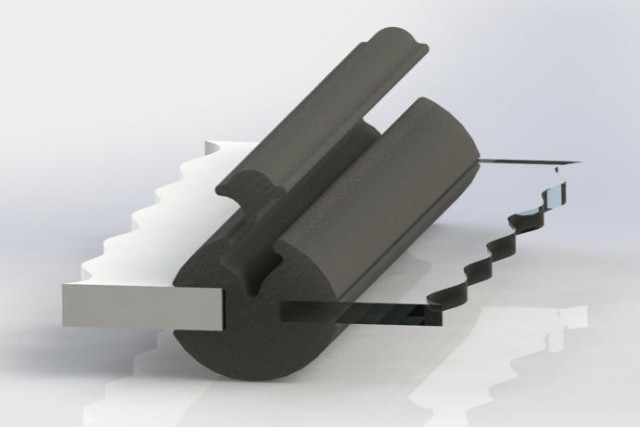Window Seal Types
11 July 2023
Boats, caravans, motorhomes and other vehicles use a range of rubber seals on their windows. Over time these seals begin to perish and need to be replaced to help stop water ingress and damage. The replacement seals you require will depend on the type of seal that is currently fitted to your boat or vehicle. This guide shows the most common types of window gaskets.
Some manufactures have historically used bespoke rubber seals on their boats, caravans, motorhomes or vehicles. These window seals may be different to what is shown below. Please get in touch if you are not able to identify a replacement for your current window section. We are happy to help identify an alternative product which may be suitable for your application. We will need to see the end profile of your current seal together with several dimensions. You can either send us a sample of your current section via post or a sketch or photograph by email.
Type 1: Claytonrite Window Seals
Claytonrite window rubbers are often used in fixed windows on boats and van conversions. They are also commonly used in machine guards and viewing windows in cabinets. These seals are available in a range of sizes depending on the thickness of the panel (ie fibreglass, aluminium etc) and the glass or Perspex.
There are three important dimensions; Gap A, Gap B and the Web thickness. Gap A and Gap B relate to the glass and panel thicknesses. These gaps are interchangeable so the glass and panel can go into either Gap A or Gap B. These glazing rubbers will seal approximately -1mm so you can fit a 2mm to 3mm thick panel into a 3mm gap. The thickness of the Web relates to the thickness of the solid piece of rubber between the two gaps. This stipulates how much smaller your glass should be in relation to the size of the hole (ie window aperture).
Claytonrite window gaskets need a filler strip (also known as beading or locking strip) to hold the seal in place and apply compression onto the panel and glass. Filler strips are available in black, chrome or white for most of our Claytonrite window rubbers. It is also recommended that you bed the rubber in with a high quality clear silicone sealant to fill any imperfections.
Type 2: Caravan and Motorhome Opening Window Seals
Caravans and motorhomes commonly have hinged opening windows. These seals are available in a range of sizes to fit most caravans and motorhomes. They are manufactured from solid rubber with a sponge rubber sealing bulb which compresses against the window and creates a watertight seal.
Our ‘How Do I Replace a Caravan or Motorhome Opening Window Rubber Seal?’ guide explains the process of measuring and identifying the correct size replacement seal.
There is a slot in the top of these window rubbers which takes a cover strip (also known as insert strip) which covers the staples holding the seal onto the wall of your van. This strip is available in grey, white or black.
Type 3: Aluminium Frame Window Seals
Aluminium frames are commonly used on boats and some older caravans and motorhomes. The type of seal you require will depend on whether your aluminium frame is fixed or sliding.
Fixed aluminium window frames require either a square U channel or wedge gasket. Our ‘How Do I Replace the Seal in a Fixed Aluminium Window Frame?’ guide explains the process of measuring and identifying seals for these windows.
Sliding aluminium window frames should be fitted with a flocked seal. These seals are covered in a velvet material which allows the window to slide within the channel. Our ‘How Do I Replace the Seal in a Sliding Aluminium Window Frame?’ guide explains the process of measuring and identifying seals for these windows.
You will need to bed both the glass and rubber gasket into the aluminium channel with a high quality silicone sealant.
Type 4: Compression Window Seals
Compression seals can be used when you have an overlapping window (ie the Perspex is bigger than the hole). A rubber sealing strip is compressed between the cabin side and window to create a watertight seal.
The best material to create a compression seal is either plain or adhesive backed expanded neoprene. This is available in strip or sheet form, depending on whether you require linear lengths or a large sheet to cut custom sized gaskets. As this is a sponge material, it is advisable to make pilot holes in the seal for the screws. This will help prevent the seal from being damaged when the screws are inserted and tightened.
We recommend that you smear clear silicone onto both faces of the seal. This will help reduce imperfections in the cabin side and keep the gasket in place. You should also cover the screw in silicone prior to fixing the Perspex onto the cabin to reduce the chance of water ingress in these areas.
Type 5: S Shaped Window Seals
S shaped window rubbers are used on small windows where the glass or Perspex is larger than the aperture. These seals do not need a filler strip so should only be used on small windows, cabinets and inspection hatches.
In a similar way to Claytonrite window seals, these sections have two important dimensions; Gap A and Gap B. Gap A and Gap B correspond to the glass and panel thickness and are interchangeable. These window seals will seal approximately -1mm so you can fit a 2mm to 3mm thick panel into a 3mm gap.
If you have a large window or heavy glass pane, you should use an S shaped Claytonrite window gasket with filler strip.
Type 6: S Shaped Claytonrite Window Seals
S shaped Claytonrite window seals are designed to be used on windows where the glass or Perspex overlaps the window aperture.
These overlapping Claytonrite seals have two important dimensions (Gap A and Gap B) which correspond to the glass and panel thickness. Your glass or panel thickness may be slightly different to the dimensions displayed on our seals. However, these gaskets will seal approximately -1mm so you can fit a 4mm to 5mm panel into a 5mm gap.
Unlike smaller S shaped seals, these window gaskets require a filler strip (also known as locking strip or beading). This filler strip applies compression against the glass and panel and helps keep the section firmly in place. Filler strips for these sections are available in black, chrome or white. When fitting the seal we advise that you bed the rubber in with a high quality clear silicone sealant to fill any imperfections.






